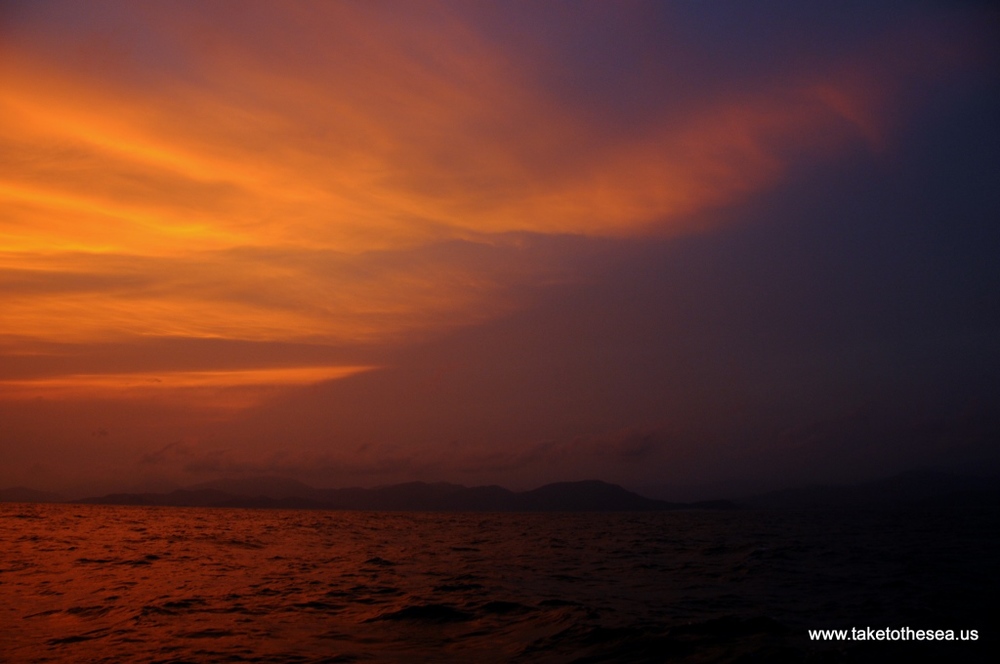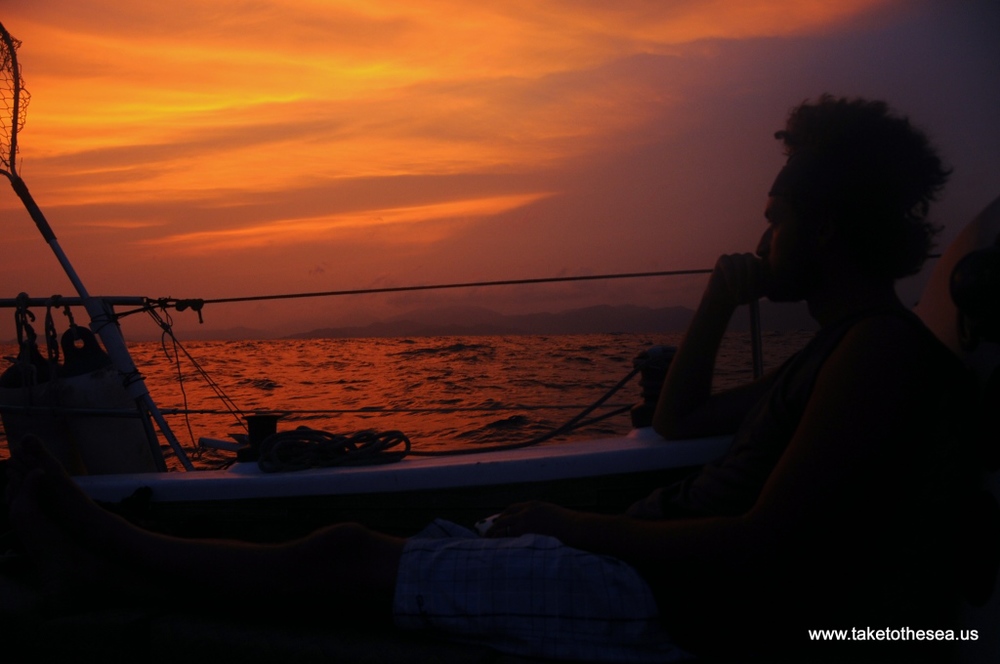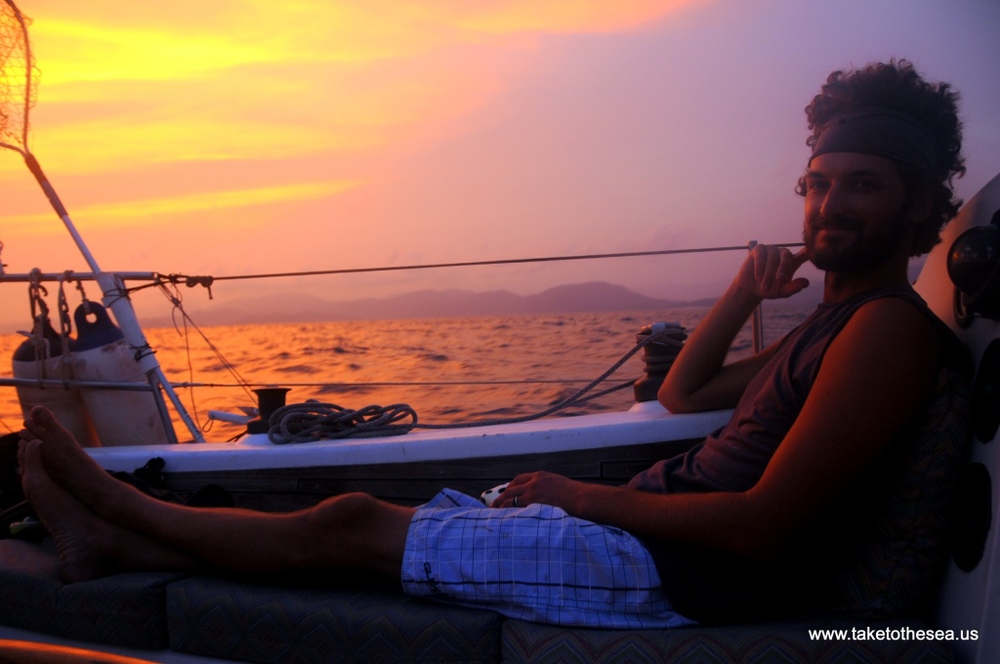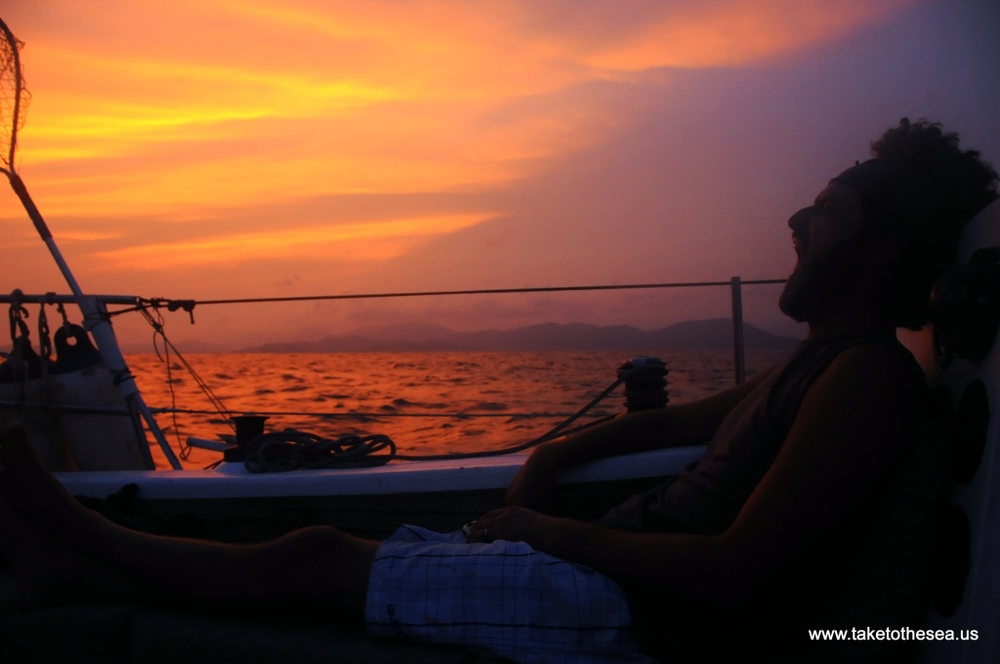- Port of departure: Bahias de Huatulco (Marina Chahue), Mexico
- Departure date and time: 9:00am on Tuesday, May 21
- Port of arrival: Puerto Chiapas
(Marina Chiapas), Mexico - Arrival date and time: 3:00am on Thursday, May 24
- Total travel time: 2 days and 18 hours (66 hours)
- Miles traveled: 261 nm
- Engine hours: 1088.0 – 1105.0 – 17 hours
- Fuel consumption: 6.8 gal
- Fuel economy: 38.4 mpg
- Forecast: Another favorable forecast with winds from 10-15 knots at
our back or side (W/NW) and small seas in the 1-3 foot range. We needed to
leave pronto, however, since a tropical storm (which would later become
Barbara) was predicted to form in the Golf of Tehuantepec later in the week.
Ooooweee! What a ride! We
weren’t expecting the winds to be as strong as they were and the seas to be as
boisterous, but they were both working in our favor. During the first day and
night we had winds up to 20 knots and were making swift progress towards our
destination, oftentimes exceeding 6 knots. At times the wind and waves overpowered
the doctor, but for the most part he was able to withstand the combination.
The Gulf of Tehuantepec is known for the
“Tehuantepeckers,” a strong N/NE wind that can stir up some very uncomfortable
seas and make forward progress difficult if not impossible. The dreaded
Tehuantepeckers (T-Peckers for short) materialize when trade winds from the
Atlantic stack up in the Gulf of Mexico, then funnel across the topographically
challenged (i.e., flat) land mass connecting the upper portion of Mexico with
it’s lower portion. Anyone sailing in Mexico
has heard plenty about the T-Peckers.
There are many strategies that you can
follow when crossing the Gulf. There’s the one foot on the shore strategy where
you’re literally cruising along in 30 feet of water less than one mile from
shore (this provides the most protection from the wind and waves (since there
is relatively little fetch for the waves to build). You can start of with the
one foot on the shore strategy, then at the 16° line reassess the weather and
decide to “cut the corner” so to speak. Or you can take the direct route across
the bay (the “rhumb line”), which puts you 40-50 miles offshore and leaves you exposed should the
T-Peckers start blowing.
Despite the fact that the
wind was at our back and side, we decided to follow the “one foot (kind of) on
the shore” strategy in the unlikely event that the winds shifted. In the end,
this strategy only adds a few extra miles and if the proverbial goes down then
you can easily drop anchor in the shallow water. Since we were sailing along
the lee shore (the wind was pushing us towards shore), we gave ourselves a bit
more wiggle room by staying 2-3 miles offshore.
Fortunately for us, the
Gulf of Tehuantepec has a sort of toilet bowl effect, by which I mean the wind
and waves remained at our back as we followed the curve of the coast line. The
first day and night was beautiful, fast sailing. In the middle of the night we
approached Salina Cruz, an industrial port, whose bay was full of freighters
anchored at odd angles. I passed off the stick to Jeff before we reached them.
When I awoke for my shift Jeff, with a hint of pride in his voice, pointed at
the scattered lights of the port – “I was dodging parked freighters for half of
my shift,. That’s some precision sailing right there.”
The second day was more
mellow than the first. The wind died for a few hours in the morning, leading us
to motor for a spell until we had wind at our side again. The swell was gentle
and there were no wind waves. In the late morning we experienced a short but
intense deluge, which soaked me to the bone before I could hop inside and close
the hatch. The days were hot, hotter than we’d experienced, and shade was a
necessity. We were passed by numerous fishing pangas on the second day – our
own attempts at fishing were unsuccessful.
On the second night, just
as the sun was setting, we could see a storm cell approaching. At 7:30pm we
were 30 miles from our destination, only 5.5 hours at our current 5.5 knot
pace. The wind changed from a W wind (at our side) to a S/SE wind, on our nose,
dropping our speed and necessitating a tack. We opted to take the sails down
and motor the rest of the way rather than tacking back and forth towards our
destination. At 4 knots it would take us about 7.5 hours of motoring through a
headwind, rain, thunder and lightening.
I’ve said before that I
love storms, especially thunder storms, but it’s a mixed bag when you’re on a
boat. On one hand you have the best seat in the house, you can see each bolt of
lightning as it materializes and strikes. On the other hand, you’re a big
metal stick in a giant puddle. You are doing exactly what your mother told you
not to do – “Don’t stand in the middle of a puddle with your umbrella waving
around in the air during a lightning storm. Make sure there’s a taller object
nearby – the lightning will want to hit that before it wants to hit you.”
Well, now we’re usually the tallest thing around, unless of course we happen to
be at a marina, in which case, I feel pretty okay because we are definitely the
shortest mast.
I particularly enjoyed
this storm, however, because I was reading the very end of the final book in
the Harry Potter series and our setting made the events in the book even more
dramatic. I huddled in the corner of the cockpit, our shade cloth protecting me
from fat raindrops, and gasped as wands whipped through the air, spells were
cast, thunder rolled and lightning struck. Too much excitement. There’s no way
I could have slept through it.
We entered the dredged
harbor at 2:30am and initially had a difficult time finding Marina Chiapas. We
had guidebooks to point us in the right direction, but according to our
electronic charts it looked like the marina was located smack dab in the middle
of land. Turns out it had been. They dug a whole new area out of terra firma to
accommodate the yatistas. Fortunately, the week prior, the marina managers had
installed some channel markers leading us back to the back corner. After bouncing
around like a pinball in a pinball machine, we finally found the entrance and
the night crew waved us into a slip.
After getting us set up
on a dock the night watchman told us to expect a visit from the Port Captain
first thing in the morning. He wasn’t lying. We were in bed by 3:30am at the
latest and the Port Captain, his two comrades and their drug sniffing dog were
knocking on our hull by 7:30am. The boat was all torn apart inside and Jeff and
I were both indecent and drowsy. I yelled out “un momentito por favor!” as I
struggled to put on some shorts and a shirt and pick up the underwear that were
spread across my settee. We looked a mess, but they were friendly and
professional and didn’t draw any attention to our disheveled state.
Our last stop in Mexico!



